The Hanuman Dhoka Palace may have long ceased to house kings, but history hasn’t moved out yet.
If visitors were allowed to enter the Hanuman Dhoka Palace from the main entryway, and stepping inside if they looked on their left, they would see an old clock on the wall beside the door. It is of a kind in which the second’s hand glides rather than ticking. That clock is an old object in a place that only has ancient things. A few feet from the clock, on the left wall, is a small door, painted in bright colors, with images of numerous deities carved on it. Members of the Malla royal family once used this door to enter their residential quarters. Today, the door is a mere reminder of the past. But it is also a marker, a point beyond which lies a world where time stands still even as the clock shaves off moments from time. Beyond the instrument that shows the passing of minutes and hours are structures that have withstood centuries. In the Hanuman Dhoka (door) Palace, a name derived from the image of Hanuman that stands near the entryway, kings lived and died, commissioned wonders of art and architecture, made plans for war and signed treaties of peace. History was shaped within these walls and it continues to live here.
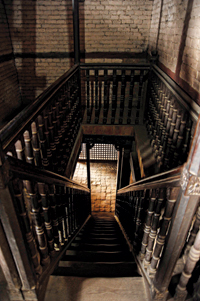 The tour of the museum is designed to take the visitor backwards in Nepali history. A steep set of stairs takes you to a room where various articles from the lives of the kings of the Shah dynasty, the last dynasty to rule over Nepal, are on display. It is a collection that traces a child’s growth as well destiny’s progress towards its fulfillment. From little dresses worn by the infant princes on their name-giving ceremonies, the collection moves to the attire they wore during their rites of passage into adulthood. The marriage dresses of the kings are on display. Slightly faded yet still redolent of the pomp and splendor are the robes worn during a coronation ceremony.
The tour of the museum is designed to take the visitor backwards in Nepali history. A steep set of stairs takes you to a room where various articles from the lives of the kings of the Shah dynasty, the last dynasty to rule over Nepal, are on display. It is a collection that traces a child’s growth as well destiny’s progress towards its fulfillment. From little dresses worn by the infant princes on their name-giving ceremonies, the collection moves to the attire they wore during their rites of passage into adulthood. The marriage dresses of the kings are on display. Slightly faded yet still redolent of the pomp and splendor are the robes worn during a coronation ceremony.
Glimpses of Regal Life
Old photos from the reign of Shah kings are recurrent objects in the collection. One is from the coronation of King Tribhuvan from 1913. Each object on display stands for a date or event in Nepali history. And often times two objects merely a few feet apart have a history of several years between them. In one corner of the first gallery is the royal throne used during the silver jubilee celebrations of King Tribhuvan in 1936. Immediately around the corner after this is a black-and-white photo showing a large crowd gathered around a raised platform under a tree. The caption tells that it is from the time when ‘an appeal was made to the people for the emancipation of slaves and abolishment of slavery’. The photo is from November 28, 1924. The appeal, the caption states, fell on deaf ears. The caption continues: ‘A new law was passed making slavery a penal offence. It provided for compensation to the slaves owners. The Nepal government had to spend a sum of Rupees 3,670,000 for the liberation scheme of the total slave population of 59,873. Compensation had to be paid for 51,782.’
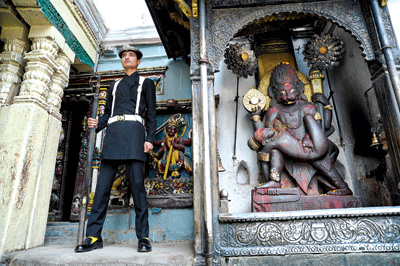 It is easy to imagine the grandeur of the life lived within these splendid walls but there is one photo that portrays the uneasiness that afflicts every mortal, including monarchs. Half-way up the second staircase that visitors must climb to progress to the next section of the museum is a photo of King Tribhuvan. His face is cupped in one hand. Thin wisps of smoke escape from a lit cigarette. The king is lost in thought. His face shows that whatever he is thinking about is weighing down on him. He wears an expression that we would think monarchs never have. I could not help wonder how many kings before him and how many after him have had that expression in some room of this world of splendor, riches, and power.
It is easy to imagine the grandeur of the life lived within these splendid walls but there is one photo that portrays the uneasiness that afflicts every mortal, including monarchs. Half-way up the second staircase that visitors must climb to progress to the next section of the museum is a photo of King Tribhuvan. His face is cupped in one hand. Thin wisps of smoke escape from a lit cigarette. The king is lost in thought. His face shows that whatever he is thinking about is weighing down on him. He wears an expression that we would think monarchs never have. I could not help wonder how many kings before him and how many after him have had that expression in some room of this world of splendor, riches, and power.
 The next section is a record of Tribhuvan’s life. Out of scores of photographs of the king there is one especially interesting photograph. It must have been taken shortly after the arrival in Kathmandu of the British expedition that had reached the summit of Mount Everest in 1953. In it King Tribhuvan is flanked by John Hunt, the leader of the expedition, and the two heroes, Tenzing Norgay and Edmund Hillary. Besides the historic achievement leading up to the photo, it is the expressions of the trio of mountaineers that sets it apart: Hunt looks casual; Tensing has a wide grin on his face, his teeth made whiter by his sun-darkened face; Hillary looks haggard and too weary to even change his demeanor.
The next section is a record of Tribhuvan’s life. Out of scores of photographs of the king there is one especially interesting photograph. It must have been taken shortly after the arrival in Kathmandu of the British expedition that had reached the summit of Mount Everest in 1953. In it King Tribhuvan is flanked by John Hunt, the leader of the expedition, and the two heroes, Tenzing Norgay and Edmund Hillary. Besides the historic achievement leading up to the photo, it is the expressions of the trio of mountaineers that sets it apart: Hunt looks casual; Tensing has a wide grin on his face, his teeth made whiter by his sun-darkened face; Hillary looks haggard and too weary to even change his demeanor.
A great many personal items of Tribhuvan have also been displayed. Especially beautiful is his revolver. His favorite pet bird, however, is a taxidermist’s nightmare. It has withered to a skeleton, and it is only through a note at the bottom of the cage that we know that the bird was a canary. Portraits of past rulers and queens run along the top of the walls. Outside, in a small room lies the coffin in which Tribhuvan’s body was brought to Nepal from Switzerland, a reminder not just of the death of a king but of the inescapable truth of mortality.
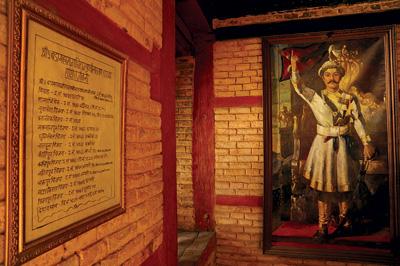 The very next room is where Prithivi Bikram Shah, another king of the Shah dynasty, was born. In the room contiguous to this one are two pairs of tusks. They belonged to the prized tuskers of the royal stables. The sheer size of the tusks stimulate thoughts of ceremonies when the elephants to whom these tusks belonged must have ambled down the streets just outside the palace, decked in regalia and mounted by a monarch.
The very next room is where Prithivi Bikram Shah, another king of the Shah dynasty, was born. In the room contiguous to this one are two pairs of tusks. They belonged to the prized tuskers of the royal stables. The sheer size of the tusks stimulate thoughts of ceremonies when the elephants to whom these tusks belonged must have ambled down the streets just outside the palace, decked in regalia and mounted by a monarch.
The next display is a bit of a surprise given the importance the exhibit housed there has had in the days when Nepal was a monarchy. At the end of a long, narrow room is a pair of thrones that were used during coronation ceremonies in the past. On one wall in the room is a photo of the coronation ceremony of King Gyanendra, the last king of Nepal. It serves as much to remind who the last person to sit on that throne was as to point out that he was probably also the last ever.
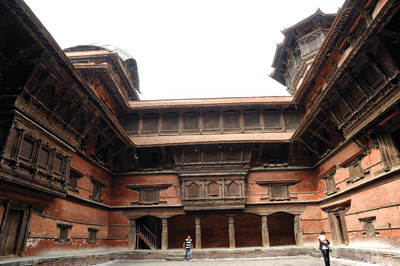 Built for Pleasure
Built for Pleasure
The Arsenal Gallery in the museum is a small room that houses antique guns, including Prithivi Narayan Shah’s gun. Another gun has a caption that touts it as the gun that Prithivi Narayan Shah ‘used in unifying Nepal’. There are Tibetan guns and a canon that were captured during the Second Nepal-Tibet War in 1854. Guns made by Gehendra Sumsher are also on display. Another Nepal-made gun, the Sundarijal rifle, made in the Sundarijal Arsenal is also part of the collection.
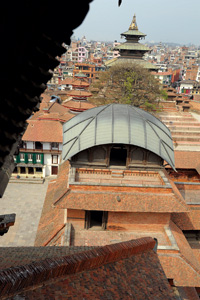 Descending a stairwell you arrive at a room full of struts, windows, terracotta figurines, stone and wooden sculptures, and numerous other objects that were once a part of the palace buildings. The room is a sudden shift from the time of the Shah kings to the art and architecture of Medieval Nepal. It is also a teaser, for many parts of the palace from where these artifacts have been salvaged are closed to the public. The room leads to the Nautaley Darbar, the nine-storied building built by Prithivi Narayan Shah in A.D. 1770. The building is also known as Basantapur, or the Mansion of Spring, a name that has come to denote the area of the city in the vicinity of the structure.
Descending a stairwell you arrive at a room full of struts, windows, terracotta figurines, stone and wooden sculptures, and numerous other objects that were once a part of the palace buildings. The room is a sudden shift from the time of the Shah kings to the art and architecture of Medieval Nepal. It is also a teaser, for many parts of the palace from where these artifacts have been salvaged are closed to the public. The room leads to the Nautaley Darbar, the nine-storied building built by Prithivi Narayan Shah in A.D. 1770. The building is also known as Basantapur, or the Mansion of Spring, a name that has come to denote the area of the city in the vicinity of the structure.
The Basantapur Palace was built, according to Prithivi Narayan’s inscription, to serve as a pleasure pavilion. A better structure could not have been built for pleasure’s sake. After climbing a series of steep wooden staircases, one arrives at the pavilion on the top floor. It is enclosed by a wall of latticed wood. To the north is the imposing temple of Taleju, the tutelary goddess of the Malla dynasty. A stark contrast to this view is the frenetic life on the streets below on the south side. On the west are partial views of old courtyards, or choks, some of which are being renovated. Sections of old choks are also visible on the eastern side, but the most attractive structures in that direction are the three towers that rise from the corners of the old courtyard. All three towers are of differing architectural design. The octagonal tower is Laksmivilasa, the square-shaped one is Vilasamandira, and Bangala is the rectangular one. Today, the one in the southeast is known as Lalitpur Tower, to the southwest is the Bhaktapur Tower, and in the northwest is the Kirtipur Tower—names derived from the cities that lie in the direction in which the towers are located.
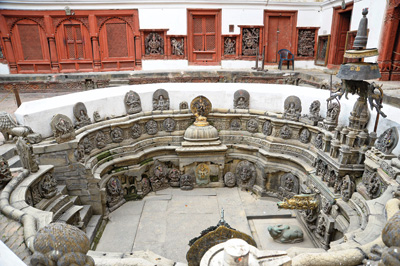 It is also believed that the three towers combined with the Basantapur Palace were built to be watchtowers. But watching the snowy tips of distant mountains to the north as the cool winds pass through the pavilion, I cannot think of this place as a sentry’s post. It has an ambience fit for a king. Today, it is a favorite with teenaged couples. Here, nine stories above the travails of life, it is easy to feel like a king or a queen—or at least until the next horde of visitors come up.
It is also believed that the three towers combined with the Basantapur Palace were built to be watchtowers. But watching the snowy tips of distant mountains to the north as the cool winds pass through the pavilion, I cannot think of this place as a sentry’s post. It has an ambience fit for a king. Today, it is a favorite with teenaged couples. Here, nine stories above the travails of life, it is easy to feel like a king or a queen—or at least until the next horde of visitors come up.
The King of Kings
From the Basantapur Palace the tour passes through two more section on Shah kings, ending with a section on King Birendra. The exit passage from this section leads out on to a courtyard known as Lohom (Stone) Chok. From there one arrives at the open expanse of the Nasal Chok. This is perhaps the most significant of all courtyards in the palace, for it was here that ceremonies of all kinds have taken place since the sixteenth century. The chok is silent except for the occasional sounds of a guide explaining something to a group of tourists. But the art and architecture within it speak volumes of the time when they were fashioned.
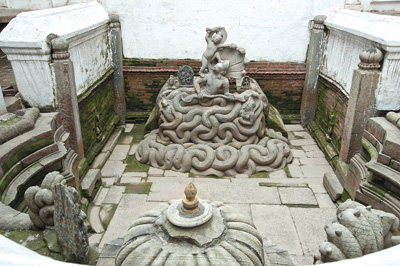 Once there were over forty choks in the palace. Today only ten remain. The courtyards are reminiscent of the Malla Period of Nepali history, for although kings of another dynasty lived in the Hanuman Dhoka Palace before them, it was during the Malla Period that additions were made to the palace that gave it its architectural and artistic charm. And amongst the Malla rulers the name of Pratap Malla, who occupied the throne from A.D. 1641 to 1674, stands out. The most interesting features of the palace, whether aesthetically or architecturally, of religious or secular inspiration, are the result of Pratap Malla’s devotion, vision, knowledge, and eccentricities.
Once there were over forty choks in the palace. Today only ten remain. The courtyards are reminiscent of the Malla Period of Nepali history, for although kings of another dynasty lived in the Hanuman Dhoka Palace before them, it was during the Malla Period that additions were made to the palace that gave it its architectural and artistic charm. And amongst the Malla rulers the name of Pratap Malla, who occupied the throne from A.D. 1641 to 1674, stands out. The most interesting features of the palace, whether aesthetically or architecturally, of religious or secular inspiration, are the result of Pratap Malla’s devotion, vision, knowledge, and eccentricities.
The Nasal Chok is the biggest quadrangle in the palace. Besides occupying a central location in the palace, the courtyard has also been a centre for various events in the palace. One of the most spectacular events that took place in the Nasal Chok in the days of Malla kings was the ritual dances, during which groups from various villages in the Kathmandu Valley performed dances for the king. The dances were performed on the stone platform that still exists in the middle of the chok. The name of the courtyard itself is derived from a shrine of Nasaleshwar, or the Dancing Shiva, located on the eastern wall of the chok. Perhaps the biggest patron of these dances was Pratap Malla, who was known to himself participate in these dances. The stone sculpture of Narasimha that is placed in the north-west section of Nasal Chok has an interesting history. The incident is recorded in the pedestal of the shrine. It speaks of how once during a dance performance Pratap Malla impersonated Vishnu. During the dance the god possessed the king’s body and wouldn’t let go of it even after the performance ended. One of the tantric priests of Pratap Malla’s court came up with the idea of transferring the god’s spirit into an image. The finest sculptors were summoned and ordered to make an image. The god’s spirit left the king’s body after the image was consecrated. The image is a striking sculpture of polished black stone depicting Narasimha, the man-lion Vishnu incarnation, disemboweling Hiranyakashyap on his lap. It was in the Nasal Chok that coronation ceremonies were held for the kings of the Shah dynasty.
 Pratap Malla turned to the gods for other reasons too. In A.D. 1672 he placed an image of Hanuman at the main entryway to the palace, believing the god “brings destruction on the enemy and victory to us and defends the home.” Pratap Malla built another structure within the palace to honor Hanuman. It is a temple with five circular stories dedicated to the Panchamukhi (Five-faced) Hanuman. Opposite to this temple, to the northwest is a small temple called the Agam Chen. It houses the traditional family shrine of the Malla kings. Strangely, members of the Malla royal family were forbidden from entering it. Even today it is entered only when repairs are needed.
Pratap Malla turned to the gods for other reasons too. In A.D. 1672 he placed an image of Hanuman at the main entryway to the palace, believing the god “brings destruction on the enemy and victory to us and defends the home.” Pratap Malla built another structure within the palace to honor Hanuman. It is a temple with five circular stories dedicated to the Panchamukhi (Five-faced) Hanuman. Opposite to this temple, to the northwest is a small temple called the Agam Chen. It houses the traditional family shrine of the Malla kings. Strangely, members of the Malla royal family were forbidden from entering it. Even today it is entered only when repairs are needed.
Pratap Malla’s building spree show him to be a deeply religious man. He surely was. But that wasn’t all there was to it. Pratap Malla was also (and he made this known) a highly egotistical man. In one inscription he proclaimed “there is no one like me, the pearl in the diadem of kings, neither in heaven nor on the earth nor anywhere in the ten directions, nor in the hills and forests.” He was a savant and a bragger, a spiritual man who was highly belligerent in his policies towards his neighboring states. He had a penchant for not only commissioning but acquiring (sometimes by force) art and sought the company of erudite men. He wrote poems, assuming the title of kavindra, or king of poets. Pratap Malla advertised his genius and intelligent for everyone when in 1654 he carved verses on the sides of a tutedhara (water spout) fitted into the outer wall of the northwest wing of the palace. The verses are written in fifteen languages. The king writes that those who can comprehend the verses are great pandits. Those who can only decipher the scripts he deems worthless. It was said that the spigot discharged milk for the “great pandits”.
The Late Malla Period, which encompassed the reigns of Pratap Malla’s predecessors and successors, was marked by bouts of war and uncertain periods of peace. The rulers of the three kingdoms – Kathmandu, Patan, and Bhaktapur – were continually at war. Peace was at a premium, and when there was genuine peace, the courts were at work to outdo each other artistically. Sword wielding armies may have got a respite but the army that worked with chisel and hammer, it seems, was always at war in the Valley during the Late Malla Period. It was a fortunate coincidence that a king with the knowledge, vision, ambition and ego of Pratap Malla ruled during such a competitive time.
Crammed with Art
Perhaps the best examples of the lofty levels to which art and architecture reached under Pratap Malla’s rule are to be found in the two courtyards that were recently opened to the public for the first time ever. The first of the two, Mohankali Chok (formerly k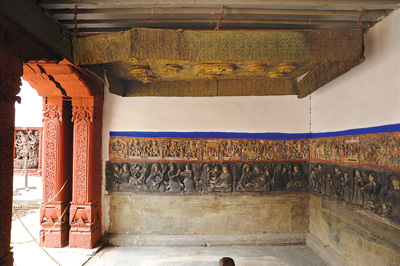 nown as Mohan Chok), was built in 1650 A.D. to function as the residential quarters of the king. The thriving trade with Tibet had brought Pratap Malla a sum of four crore rupees. He buried the money and built the Mohan Chok over it. According to legend, the money still remains buried under the courtyard and that clues to its discovery are concealed in the arcane polyglot verses carved on the chok’s outer wall.
nown as Mohan Chok), was built in 1650 A.D. to function as the residential quarters of the king. The thriving trade with Tibet had brought Pratap Malla a sum of four crore rupees. He buried the money and built the Mohan Chok over it. According to legend, the money still remains buried under the courtyard and that clues to its discovery are concealed in the arcane polyglot verses carved on the chok’s outer wall.
Treasure lies also above the ground. The Mohankali Chok is a cache of Malla Period art. “It is an integration of four forms of art,” says Saraswati Singh, Executive Director of Hanuman Dhoka Darbar Museum Development Committee. “There are paintings and sculptures of wood, stone and terracotta in the chok.” It was here that treaties were signed between rulers and guests of the king entertained. In the past only the king and his family, guests or other heads of states were allowed to enter Mohankali Chok. The only other way to gain entry was to stir trouble. Rebellious characters in the royal family were punished by being tied down on the ground floor of the courtyard. A connoisseur of art would have turned rebel within moments to be “punished” and held captive in a place full of unmatched artwork such as this.
The Mohankali Chok is crammed with art. Wooden sculptures line the walls. The slaying of demons by gods is a motif of the wooden sculptures here. Terracotta panels with relief designs line the base of the courtyard’s verandahs. There are also terracotta statues of numerous deities behind a latticed wood section of the western wall. Above these images are faded murals. But the main attraction of the courtyard is the bath of the Malla kings. In the depth of this pit is a golden spigot. Heads of different creatures emerge one from the mouth of another before culminating in the tip of the spigot that once discharged water channeled all the way from Budanilkantha. The bath is crowded on all sides of its depth (12 feet) by stone images of gods and mythical characters. Prayag Raj Sharma, a renowned anthropological historian, explained to me the reason behind having so many images in the bath. “Having so many images of gods installed in the bath allowed the king to see almost all the gods he would invoke during his morning ablutions.”
The courtyard has images of mortals too. On the wall of the northern verandah of the chok are painted some confounding and intriguing scenes. Most scenes depict the daily activities of Pratap Malla’s life. But there is a scene in which a child is peering through a telescope. It seems an anachronism. But it is in fact a great historical record. During Pratap Malla’s reign a few Capuchin monks who were on their way to Calcutta from Lhasa had stayed on for a while in Kathmandu. One of them, Father Grueber, had presented a telescope to the king. In the same series of paintings women have been depicted in Western attire. There is no explanation for this anachronism.
To the north of Mohankali Chok is the Sundari Chok (known formerly as Kalindi Chok), another of the residential courtyards built by Pratap Malla. It is considered to have been modeled on the chok of the same name of the Patan Darbar, which predates it slightly. This courtyard’s ground floor is bland and empty in comparison to Mohankali Chok. But the artwork that adorns the bath in this chok has no equal either in the Mohankali Chok or anywhere else. This is a stone sculpture hewed from a single block of stone that depicts the story of the subjugation of Kaliya, a tyrannical serpent, by the child god Krishna. The episode is known as Kaliyadamana. Blessed with an eye for art and a connoisseur’s knowledge, Pratap Malla had brought this sculpture from a Licchavi ruin to decorate his bath. Mary Slusser, author of Nepal Mandala, has called the sculpture ‘perhaps the most perfect Nepali stone masterpiece of all time.’ The other stellar feature of the Sundari Chok is the windows on its first floor. There are windows of ten different designs in a courtyard whose length and breath do not exceed 30 feet.
As you step out into the Nasal Chok once again after visiting Mohankali and Sundari Chok, you might catch a glimpse of the time on the clock on the wall as you head for the exit. You probably will be surprised at how time has flown by. No matter how much time you spend in the Hanuman Dhoka Darbar Museum, what you get in return is priceless. Here, by spending mere minutes, you can enter a world that took centuries to build.








